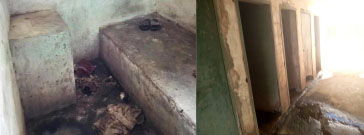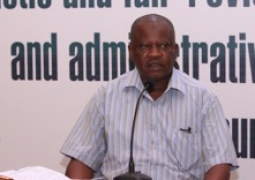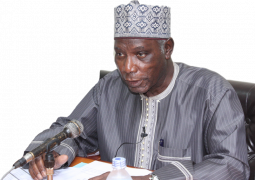
The Security Wing “was unfit for human beings,” according to all the security detainees who testified before the Commission. According to Ebrima Ismail Chongan, “the cells were 2m x 1.5m with a steel door painted black. They were bare, except for a 1.90m and 40cm wooden plank bed, a chamber pot for toilet and a one-liter plastic bottle for water.
Another witness, Abubacarr Sulayman Jeng who was also incarcerated in Security Wing No. 4, described the situation as despicable. “We were placed in tiny cells measuring 1x6 metres, slept on a plank of wood without a pillow and blanket, and provided a chamber pot (bucket for the call of nature) and a plastic bottle for drinking water.
The cell was fitted with a metal door that had tiny openings atop and a window that provided passage for mosquitoes. The area was infested with mosquitoes and aggressive rats, making sleep impossible. Security Wing No.1 was no better. It was described as a “hell hole”.
He opined that “these cells had not been repaired since the prison was built by the British colonialists.” Like the cells in Security Wing No 4, their “amenities were a plank of wood, one liter bottle of drinking water and a chamber pot for the call of nature.”
Dr. Badara Loum, a former permanent secretary of Agriculture who was detained several years later in 2006, described Security Wing No.5 as a place that was “not fit for animals and not the type of place that you can keep human beings.” There was no light in his cell which measured about 2m by 2.5m. “There was a bucket to ease yourself and some bottles of water that you were supposed to use throughout the night.”
Ansumana Manneh, the director general, attested to the fact that the Security Wing was unfit for human beings, and that detaining anyone under such conditions was inhumane.
He confirmed that the prisoners used to sleep on planks, as there were no beds or mattresses the cells would also leak during the rainy season, and some of the inmates would get pneumonia. According to him, the condition of Mile II Central Prison was so harsh and deplorable that even the staff were not immune to its effect.
“The dampness on the walls and leaky roofs exposes the inmates and staff to infections. Malaria and chest infections are frequent occurrences. The place is overcrowded and is not safe or healthy for the inmates and the prison officers.”
When the TRRC visited the Mile II Central Prison on the 18th January 2019, the Commissioners were appalled at the unsanitary and inhumane and degrading conditions of Mile II Central Prison, especially the security wings where detainees were kept.
“This situation of persons languishing in detention without their cases being heard or in some instances without ever being taken before the courts is a gross violation of the right of prisoners to have access to the justice system. In addition, the TRRC noticed that there were many young people in detention or on remand for petty crimes that ought not to attract significant custodial sentence. Putting these young people in the same space as hardened criminals without providing rehabilitation services for them exposes many of them to the risk of developing anti-social behaviours.”
From the testimonies, it is evident that the conditions of the cells in the Gambian prisons are unfit for human beings, and even more so in Mile II Central Prison. The place is susceptible to mosquito and rat infestations and other vermin, which constitutes a serious health hazard to prisoners and staff alike.
“The horrid conditions were not limited to the Security Wing at the prison. They extended to the Main Yard and Remand Wings. All the witness’ testimonies indicate terrible conditions across the board, including in the other two prisons – Jeshwang and Janangbureh.”
Read Other Articles In Headlines

Wellingara alkalo decries water shortage as Barrow’s tour continues
Sep 30, 2021, 12:08 PM

Commission grants Alagie Hydara time to provide cashbooks, other records
Jan 30, 2025, 9:47 AM



